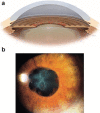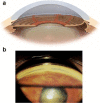Neovascular glaucoma: a review
- PMID: 27895936
- PMCID: PMC5116372
- DOI: 10.1186/s40942-016-0051-x
Neovascular glaucoma: a review
Abstract
Neovascular glaucoma (NVG) is a secondary glaucoma generally associated with poor visual prognosis. The development of new vessels over the iris and the iridocorneal angle can obstruct aqueous humor outflow and lead to increased intraocular pressure. The underlying pathogenesis in most cases is posterior segment ischemia, which is most commonly secondary to proliferative diabetic retinopathy or central vein retinal occlusion. The neovascularization process in the eye is driven by the events that alter the homeostatic balance between pro-angiogenic factors, such as the vascular endothelial growth factor and anti-angiogenic factors, such as the pigment-epithelium-derived factor. Early diagnosis of this condition through slit lamp examination of the iris, iridocorneal angle and retina can help to avoid the development of goniosynechia and obstruction of aqueous humor outflow, with consequent intraocular pressure elevation. Historically, NVG treatment was focused on reducing the posterior segment ischemic process that caused the formation of new vessels, through panretinal photocoagulation. Recently, several studies have investigated the application of intravitreal anti-VEGF therapies in NVG. If clinical treatment with the use of hypotensive topical drops is not sufficient, laser and/or surgical procedures are required for intraocular pressure control.
Keywords: Anti-VEGF; Central retinal vein occlusion; Diabetes; Neovascular glaucoma; Refractory.
Figures
References
-
- Albert DM, Jakobiec FA. Neovascular Glaucoma. In: Albert DM, Jakobiec FA, editors. Principles and practice of ophthalmology. 1999, Philadelphia: WB Saunders Publishers.
-
- Vasconcellos JP, Costa VP, Kara-Jose N. Neovascular glaucoma: epidemiology and prognostic factors. Proposal of a flow chart to quideguide the treatment. Arq Bras Oftalmol. 1998;61(5):519–524.
-
- Pedroso L, et al. The real cost of glaucoma treatment for an outpatient. Arq Bras Oftalmol. 1999;62(6):677–682. doi: 10.1590/S0004-27491999000600004. - DOI
Publication types
LinkOut - more resources
Full Text Sources
Other Literature Sources





